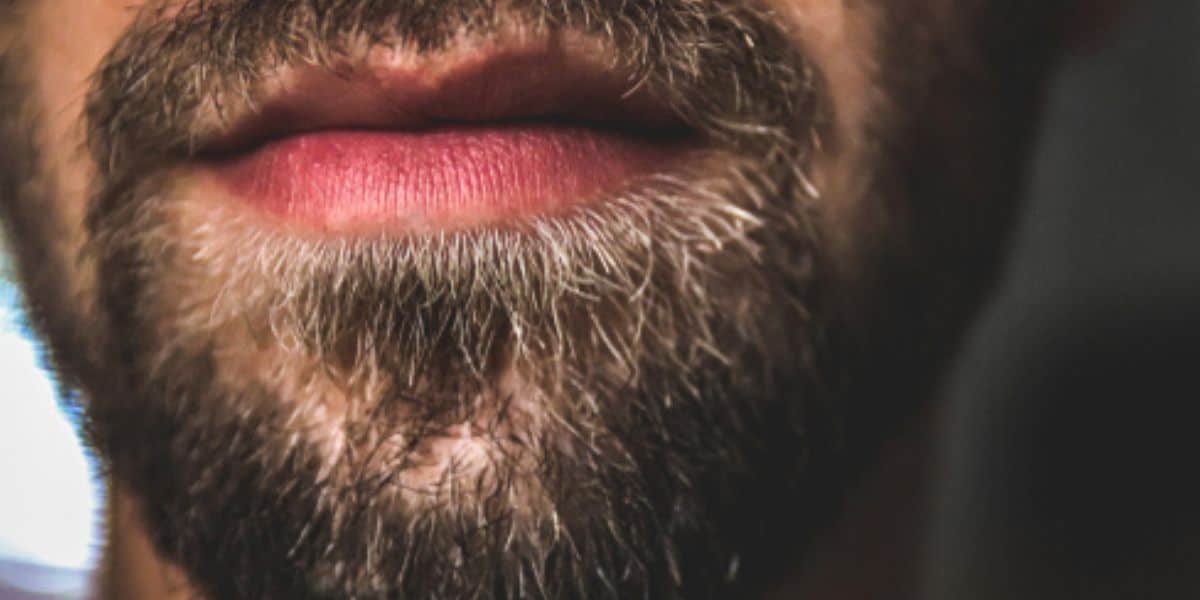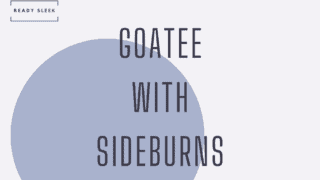The term “thin goatee” may mean different things to different people. Before we start, it’s worth clarifying exactly what this article is going to be about. Trust me, you won’t be disappointed.
A “thin goatee” refers to shape, not texture. Yes, “thin” is a term used to refer to the patchiness and sporadic nature of hair growth.
But for the purposes of this article, a “thin” goatee is one where the goatee itself consists of thin lines and borders encircling the mouth. The goatee isn’t filled in as it would be in a Full Goatee or French Beard.
It’s a phenomenal, thoroughly modern facial hairstyle with a distinctly urban edge. Although it does lend itself well to younger adults, more and more men within older demographics are catching on to its versatility and acceptance.
I’m first going to go through several thin goatee styles you can try out for yourself. Following this, I’ll talk you through a step-by-step routine for trimming and shaping a simple, straightforward, pencil thin goatee.
Let’s get to it.
6 Best Thin Goatee Styles
A goatee refers to any style that consists of hair on the chin but not on the cheeks. Therefore, a goatee may or may not incorporate a mustache. Bear that in mind as we go through these styles.
1. Pencil Thin Goatee
This is probably the one most of you have come across. It includes both a chin beard and a mustache that may or may not connect.
Although the style works best when the two components are connected and encircle the mouth, I appreciate that this isn’t always possible.
Many men struggle to make their goatees connect, which is why I make it clear that the style doesn’t necessarily have to connect.
As the name would suggest, the goatee is “pencil thin” as if it were drawn on with a pencil. The borders are sharp and crisp, and the hair within the goatee is neatly removed.
The upper border of the chin beard is usually neatly-defined, approximately one finger-width above the tip of the chin.
Of course, as with most goatee styles, the cheek and neck hair is shaved. This is what makes it look so sleek.

2. Thin Chinstrap With Goatee
This is an interesting variant. It isn’t necessarily as “pencil thin” as the goatee style above. However, it does certainly work well when trimmed very thin as well.
A “chinstrap” is a strip of hair that runs along the angle of the jawline from ear-to-ear. It can be worn alone, although this style doesn’t have the best of reputations.
However, when combined with a different, more attractive style it can work very well as a hybrid.
For example, by combining it with a goatee.
In this hybrid style, you have a regular, Full Goatee encircling the mouth. But in addition, you have a thin chinstrap running beneath it, along the jawline from ear-to-ear.
“Thin chinstrap” is also a very subjective word, as one man’s “thin” is another man’s “thick”. But once again, one-finger-width is a pretty good benchmark.
The main benefit of the thin chinstrap with goatee style is that it nicely contours the jawline. This is something that isn’t possible with a straightforward thin goatee.
A goatee is great for elongating and adding depth to the chin. But it doesn’t do anything to define the jawline. Adding a chinstrap is a great way to achieve this.
Here’s a full article on the goatee with chinstrap if you’re interested.

3. Long Thin Goatee
This is essentially a long, thin chin beard. It’s quite a divisive style and isn’t anywhere near as common as the styles above.
Having said this, it’s quite liberating to allow your chin beard to grow downward. It can look quite stylish if adequately groomed and styled.
The long thin goatee can work alone, or simply be incorporated into a Full Goatee with a mustache present as well. All you need to have to stay true to the definition is a long, thin chin beard.
4. The Long Thin Braided Goatee
This follows the same principle as the last one but with a twist (no pun intended). A braided goatee is also a long chin beard. However, the hair is knotted to produce a phenomenally stylish braid.
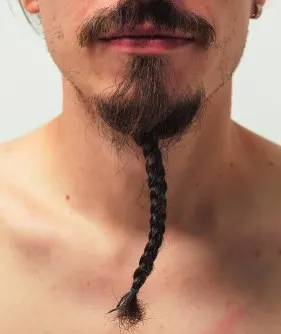
Sure, it stands out. But it’s also a great way to keep a long, thin goatee neat and tidy.
The braided goatee is about as retro as you can get, as it harks back to the days of the Vikings and will leave you feeling like a Nordic warrior.
Here’s a full tutorial on how to braid a goatee if you’re interested.
It’s one to bear in mind if you’re looking for a goatee style to help you stand out. This is pretty uncommon, but that’s one of the things that makes it so great.
5. Thin Mustache And Goatee
There isn’t a huge amount to say about this one, as it’s pretty similar to the pencil thin goatee.
Remember, the pencil goatee consists of a mustache and chin beard. If you were to make a point to thin the mustache here, you could call it a “thin mustache and goatee”. In other words, a “thin mustache and goatee” is simply a variant of the pencil thin goatee where the mustache is “pencil thin” as well.
This is important because it does add a small extra trimming requirement. Thinning the mustache can be tricky and it’s important to maintain symmetry without making it too thin.
This is something I’ll touch upon in the tutorial below. I’ll tell you at what point in the routine you may want to consider thinning the mustache down.

6. Thin Goatee With Soul Patch
It’s important not to confuse a “goatee” with a “soul patch”. A soul patch is the tiny patch of hair that lies immediately beneath the lower lip.
Although it isn’t integral to the definition of a goatee, a lot of goatees do include a soul patch. This is either intentional or unintentional.

With this thin goatee variant, the soul patch is very much intentional.
It’s essentially just a thin goatee with a neatly sculpted soul patch lying beneath the lower lip. You’ll need to make a point to make the borders of the soul patch sharp and crisp.
A soul patch can be trimmed into whatever shape you like. Oval, square, rectangular, or even triangular.
It’s a very subtle addition that can give a goatee a surprisingly sophisticated edge.
The Thick Goatee With Thin Beard Cheeks
I didn’t include this in the list above as it doesn’t quite fit. However, it’s still worth mentioning because it’s becoming increasingly popular.
It’s usually a faded beard style, as one part of the beard fades into another.
The cheeks are usually a notoriously patchy area of the beard to contend with. It can drive bearded men mad as they try to determine how to fix this.
Ultimately, there isn’t a huge amount that can be done about patchy cheek hair. The best approach to tackling it is usually changing your style up to accommodate for it.
Goatees are great for this purpose because they usually completely remove the need for cheek hair entirely.
However, for men not wanting to completely do away with their cheek hair, there’s another option.
With this style, the goatee remains intact, usually encircling the mouth. The cheek hair is still present but trimmed much shorter than the goatee. This leads to the “thick goatee with thin cheeks” look in the picture below.
It’s quite high maintenance but not very high maintenance. Sure, you’ve got to maintain two different lengths. Plus, if you’re fading one length into the other this will be a bit of extra work as well.
However, you don’t necessarily need to fade them. The style works quite well even when the border between the two lengths is clearly defined and the transition is sudden.
How To Trim And Shape A Thin Goatee
What I’m about to teach you is a step-by-step routine for trimming a simple, pencil-thin goatee. It
Once again, if your goatee doesn’t connect, don’t worry. Leave it disconnected – it’ll still look good.
You’ll need an electric trimmer or pair of clippers for this tutorial. If you haven’t already got one, check out the Philips Norelco Oneblade QP6520/70 on
1. Trim it all down to goatee length
At this point, you may have a rough outline of a goatee already and you’re just looking to neaten it up. Alternatively, you may have a fuller beard and you want to carve out a goatee.
Either way, you’ll need to trim down your facial hair to the length you’ll eventually want your goatee to be – the “goatee length”.
For the sake of this tutorial, let’s say you want it to be 8mm long.
You’ll be trimming all of the facial hair down to this length, including the parts you’ll eventually shave off like the neck hair and cheek hair.
This may sound odd, but it makes the goatee much easier to carve out if you’re starting with a “level playing field”. In other words, with all of the hair the same or of similar length.
Set your trimmer to your length of choice. In this example, we’re using 8mm. Trim it all down – your entire beard. You can vary the length a little bit in the goatee area itself.
For example, if you’re mustache is particularly thick, try trimming it 0.5 – 1mm shorter than your chin beard. This should make the goatee look more evenly distributed overall.
Once you’ve done this, you’re ready to trim the outline of the goatee itself.
2. Sculpt the outline of the goatee
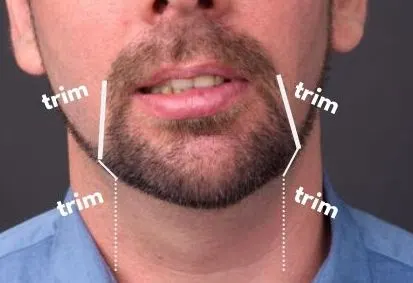
The sides of a goatee should have a very natural curve. A common mistake is to make the sides too vertical, making the entire goatee too narrow overall.
An easy way to do this is to simply think of the goatee sides as a natural extension of the mustache. Follow the curve of the mustache downward on each side, all the way down to the jawline. You’ve just visualized the outline of an ideal goatee.
As you’ll realize, the curve is gradual, gentle, and natural.
The simplest way to trim the edges of a goatee is by using the naked blade of your electric trimmer or clippers. In other words, without any attachments.
Although some trimmers do come with T-blade attachments which are ideal for lining up a goatee, it isn’t always necessary.
Using the naked blade (or an equally appropriate attachment), trim and define the goatee sides as you’ve just visualized them. Go nice and slow. Make the borders clear, crisp, and sharp.
The point where your mustache meets the side of the goatee can either be sharp or more gradual and natural. Both of these looks work well.
Then, trim all of the cheek hair on either side of this outline. It all needs to go.
Once you’ve done this, the goatee sides should be nicely aligned, symmetrical, and sharp. Now it’s time to focus on the neckline and neck hair.
3. Trim the neckline
The neckline of a goatee is narrow. It’s essentially only as wide as the width of the goatee, and this is dependent on at what points the sides of the goatee meet the jawline.
However, the neckline still needs to be at the correct height – not too low and not too high.
A good practice would be to set it two finger-widths above the level of the Adam’s Apple. This is usually a good way to go, but it’s something to experiment with as you may find a different height works slightly better for you.
Once you’ve visualized this neckline, carve it out using the naked blade of your trimmer, just like you did with the sides of the goatee.
Once you’ve done this, trim off all of the hair beneath the neckline and on either side of it. It all needs to go. Neck stubble is never attractive and always looks untidy.
4. Make the goatee borders thin and sharp
It’s time to make the goatee thin, which is sure what all of you have been waiting for. The borders can be as thin as you like. To create this effect, you’ll want to trim the hair of the goatee itself so that the inner borders are neatly trimmed.
In general, this will mean trimming any stray hairs beneath and either side of the soul patch.
Once again, using the naked blade of the trimmer, trim the inside of the goatee to make the sides nice and thin. Yes, as thin a pencil line if that’s the look you’re going for.
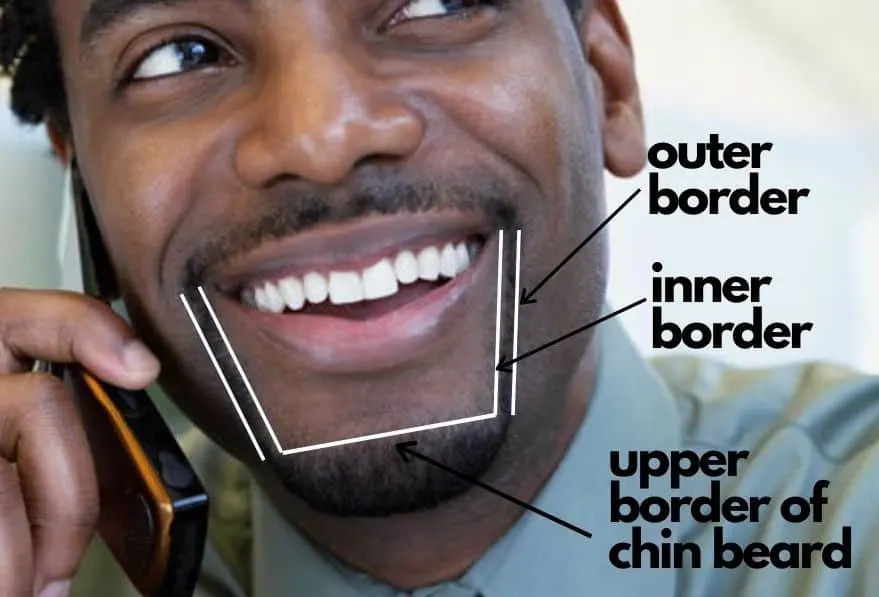
Make the borders of the soul
Then, trim any stray hairs beneath the soul patch up until the upper border of your chin beard. You can keep this upper border straight and horizontal – this is usually a good way to go with thin goatees.
At this point, decide whether you want the “thin mustache and goatee” look. Do you want to keep the mustache as it is, or make it thin?
If you want to make it thin, start making small trims from the upper border of the mustache downward. Make the mustache as thin as you would like it, but make a point to maintain symmetry.
5. Shave for perfection
Trimming with the naked blade of your trimmer produces neat results. But you’ll still be left with very short stubble, as it’ll only be able to trim down to around 0.4mm. You’ll want to shave over these areas for the best results.
To summarize the areas I’m talking about, I mean the cheeks, neck, and the area within the goatee itself (either side and beneath the soul patch).
Shaving is a great way to use a blade to further sharpen up the borders of the goatee. This is what leads to ultra-sleek results.
Conclusion
The thin goatee should be considered an umbrella term for a variety of different glorious goatee variants.
This article has shown you the best of them. You now have a great selection to choose from whenever you’re thinking of switching up your style.
Experimentation is the key to success. Have fun.
Ready Sleek founder. Obsessed with casual style and the minimalist approach to building a highly functional wardrobe. Also a fan of classic, vintage hairstyles.


